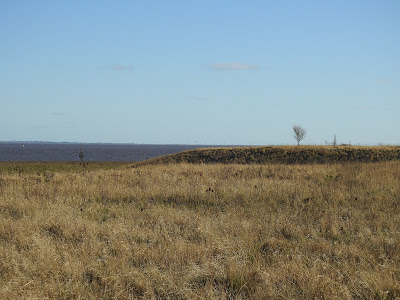First of all, I need to apologise for not posting for a while, but I have had some major computer issues. To cut a long story short, Windows 10 decided to corrupt itself, and my computer was with the repairers for four days, and I only got it back yesterday. But enough of my woes!
Metaphorically speaking, I often have to wear two hats, but when I was over on the east coast at my survey site on the Humber Estuary last week, I literally had to wear two hats as it was so cold! It was a glorious morning with clear skies, and a chilly easterly wind with plenty of lying snow.
My transect route to my VP location takes me through what you would describe as 'habitat mosaic', with lots of scrub that will no doubt support a good breeding bird assemblage, and I look forward to completing breeding bird surveys here later in the year. I've mentioned before how you get quite attached to various survey sites, and even though you might only spend a year or less at these sites, they sort of get under your skin, and feel like a local, or not so local, patch. As I walked through the scrub, I saw a flash of pink and a white rump, and there was a cracking male Bullfinch. And another white rump, and the female popped up. Not rare or even scarce birds, but I hadn't seen them here before, so that made them special.
with the white of the snow
Other species in and around the scrub were four Skylarks, eight Meadow Pipits, a Yellowhammer and two Reed Buntings. Walking towards my VP across some rank grassland with scattered Hawthorn scrub, with some small wet flashes, I flushed a Jack Snipe. And again, a new bird for the site. Or should I say a new bird for me at the site, as I am sure that Jack Snipes have been wintering here for many years.
I set up at my VP overlooking s stretch of the estuary and I started to count; 122 Shelducks, a Golden Plover, a Grey Plover, 79 Dunlin, 211 Black-tailed Godwits, 90 Bar-tailed Godwits, 48 Curlews, seven Redshanks, three Turnstones and 260 Black-headed Gulls. Looking downstream and beyond the area that I count, there were thousands of waders out on the mud, and I was quite happy that I wasn't counting them.
On my walk back to my car I encountered two Buzzards, and then I heard a rustle behind me, and on turning round two Roe Deer bucks ran past.
Back in the west this week, I completed a survey at each of my two winter survey sites and the weather had warmed up, and I had switched from two hats to a cap! I started off at the site with an area of marsh, and just after first light a few Pink-footed Geese were on the move, and the 365 birds that I recorded were moving mainly north.
The water levels were a little higher on the marsh than usual, and from my VP I could see over an area of relatively open water and counted eleven Teal and 20 Mallards. Usually, I just record Teal calling and have no idea how many there are. At least two Water Rails called from the marsh, as did a Reed Bunting.
On the arable field in front of me, I hadn't noticed the 57 Fieldfares that were foraging for invertebrates in the wet conditions until a Buzzard flew low over the field flushing them. Another Buzzard called from behind me, and a male Kestrel had a similar effect on these northern Thrushes.
Walking to my second VP, I had a Grey Wagtail feeding around the edge of a flooded field corner, and close by a Little Egret popped out of a ditch and headed south and out of sight.
Towards the end of the week, I was at my survey site virtually on the west coast. Again, it was mild with a stiff south-westerly wind and a few Pink-footed Geese headed north just after sunrise, and this time they numbered 187. I had a further seven Pink-footed Geese drop into the field that my second VP is located in, just as I was getting out of my car, and 174 in the fields to the west of my third VP.
I noticed a number of Song Thrushes in and around the area of scrub that forms part of my survey site, and I had three singing males, plus a further two individuals. A Little Egret made an appearance here too, and probably the highlight of the morning was the Woodcock that I flushed from the edge of the scrub.
Restrictions have been relaxed by the BTO for carrying out surveys, or perhaps more accurately the guidance from the government is a little clearer, and survey work is allowed to continue during lockdown. We just need an improvement in the weather, and I should be able to do some ringing again.








No comments:
Post a Comment